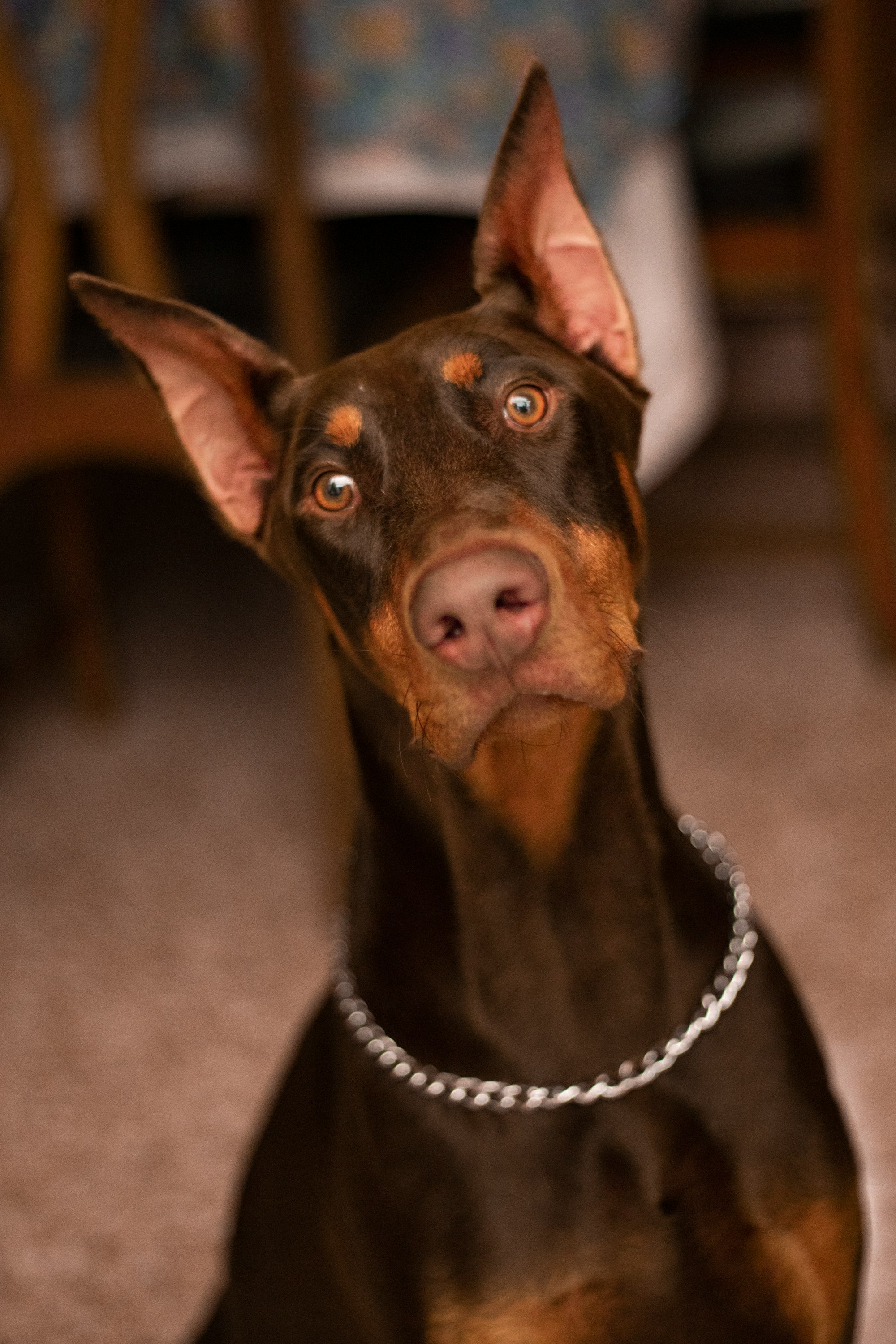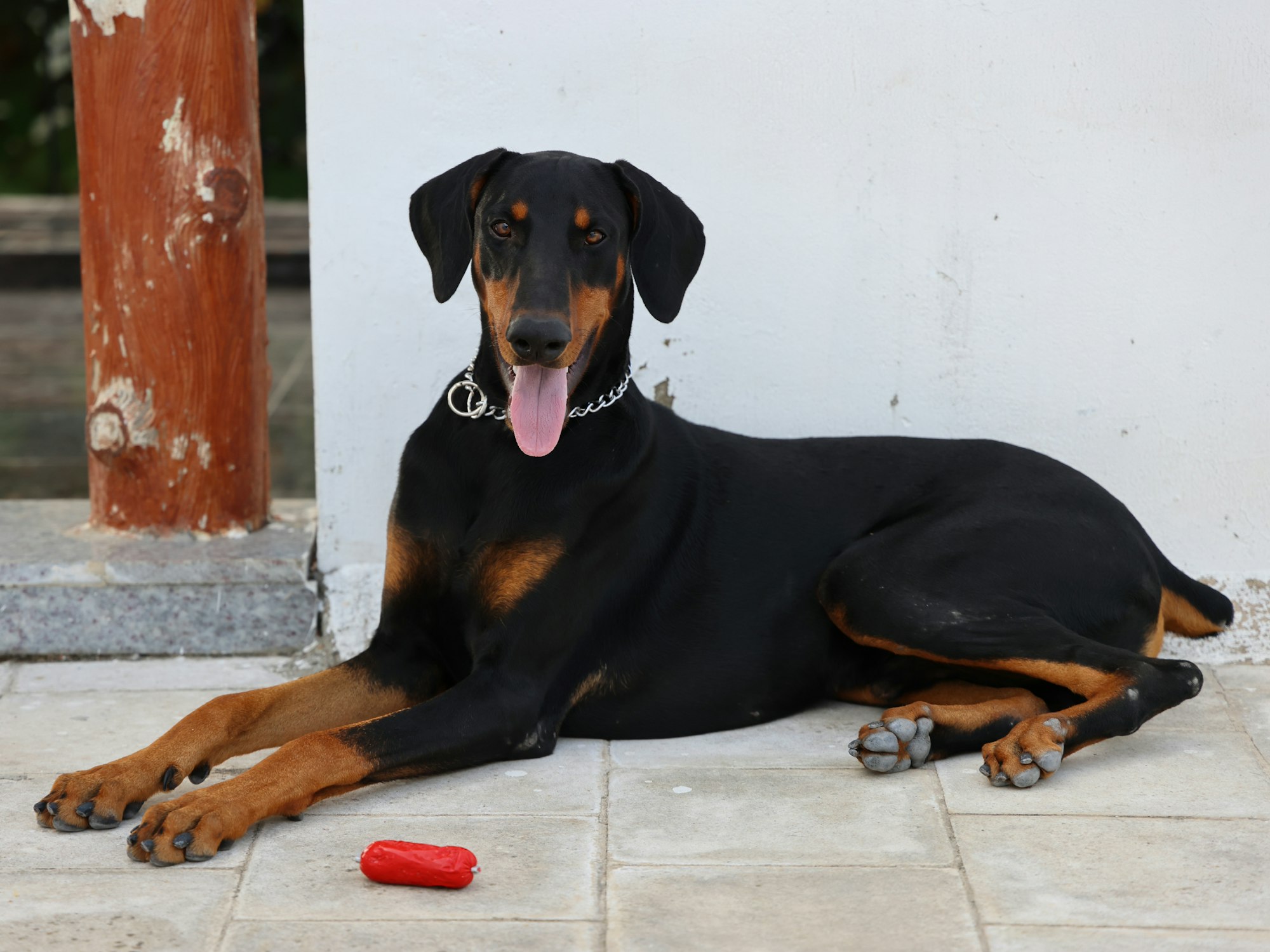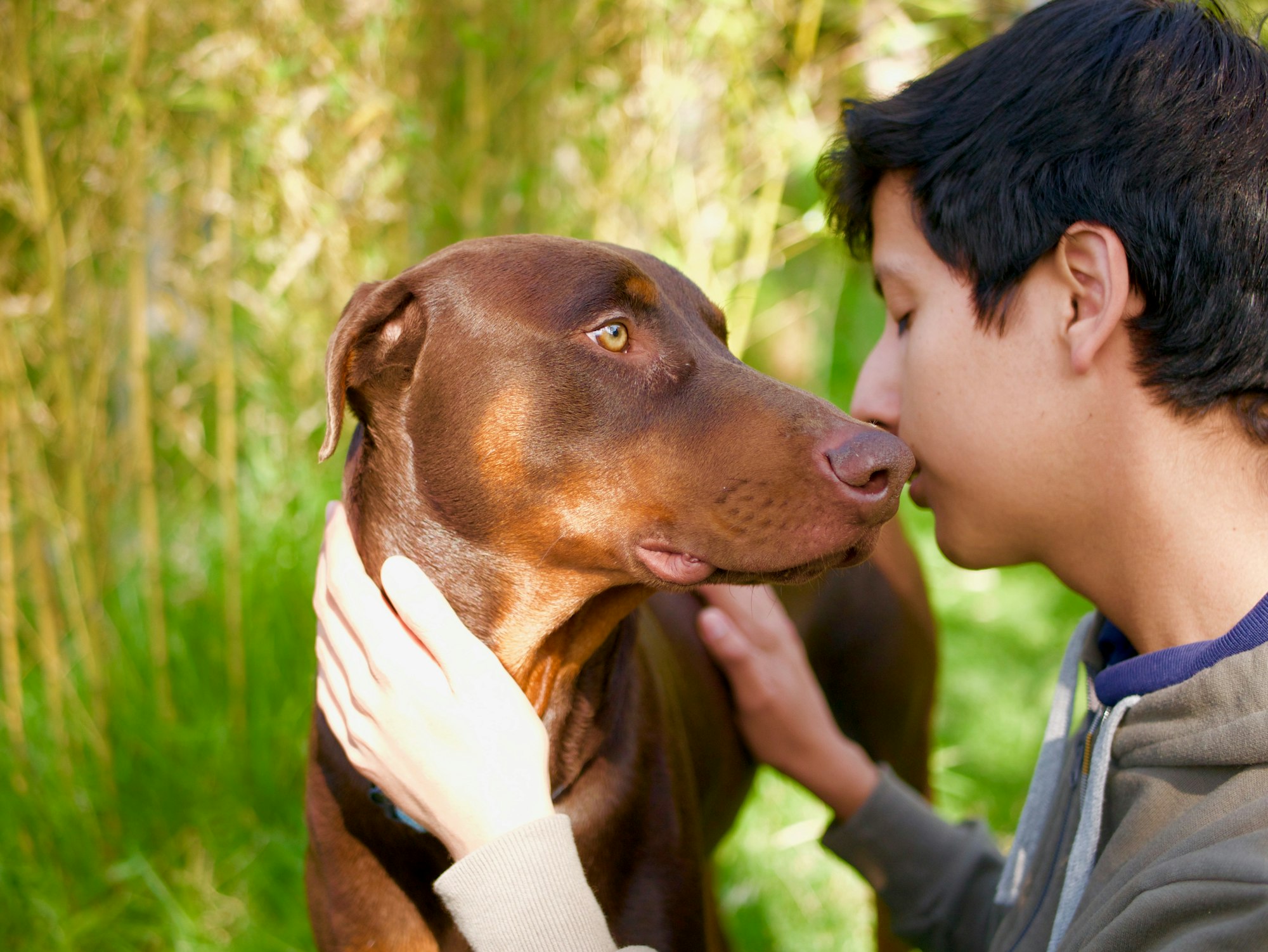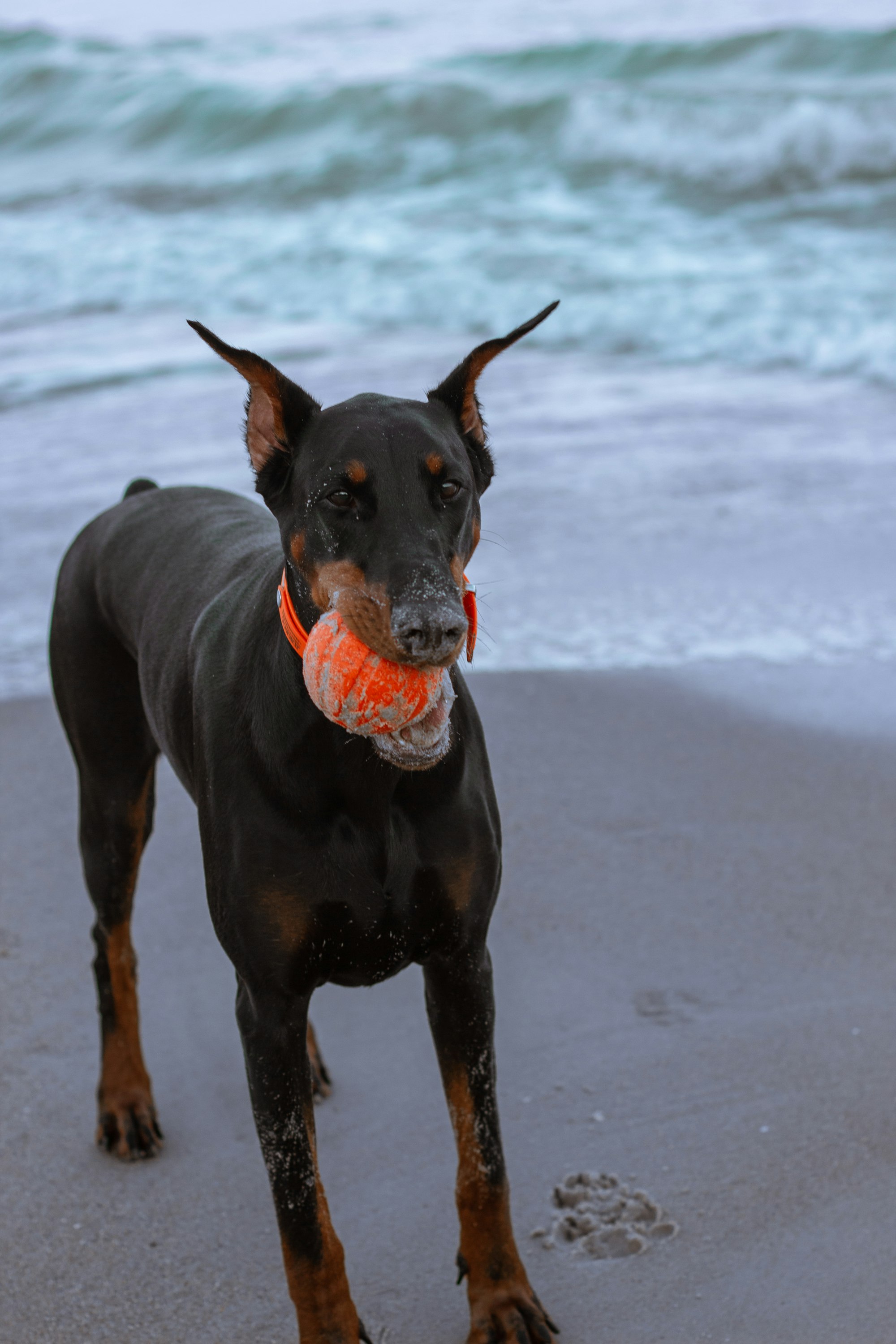It is necessary to briefly trace the origins and traits of this lovely dog breed to answer the question "Are Dobermans good with kids?" The Doberman (also spelled Dobermann) dog breed, or Doberman Pinscher in the US and Canada, was originally bred in 1890 by German tax collector Louis Doberman. They were created to offer protection to humans, an attribute that is still evident in present-day breeds, even after subsequent breeding modifications.
Read on to find out more about Dobermans and being around children.
Protect Your Doberman with the Fi Dog Collar: GPS Tracking and Geofence Alerts
Introducing the Fi Dog Collar, an essential companion for Doberman owners seeking to provide the best care and protection for their loyal pets. This smart collar, equipped with GPS tracking, offers precise location tracking, activity monitoring, and sleep pattern analysis, giving you insights into your Doberman’s health and well-being. The innovative geofence feature sends instant alerts if your energetic Doberman ever manages to escape the backyard, ensuring a swift recovery.
With the Fi app, you can keep track of your dog's movements and receive real-time notifications, making sure they're safe and sound, whether they're at home or exploring the great outdoors. Take the next step in ensuring the safety of your Doberman - try the Fi Dog Collar today and experience peace of mind like never before!
Are Dobermans Good With Kids?
Doberman Pinschers are usually family/people-oriented, loyal, tolerant, and friendly dogs that get along very well with kids of all ages if properly trained and socialized.
This is especially the case for a Doberman that has been raised with kids from a young age. Note that training is not only for the Dobermans; kids also need to be trained on how to cope comfortably with these pets.
In other words, they should think about how not to offend these energetic dogs as well as how to respect them and show them love. If they abide by these principles, then they should also expect love, kindness, and protection from their pets.

Doberman Pinschers and Children: The Protective Instinct
Most dog breeds are instinctively protective, but Dobermans are the only kind of dogs in the world that were bred for the purpose of offering humans personal protection. Hence, Doberman Pinschers naturally come with a highly advanced protective instinct for every member of their host family or pack.
This protective nature and their high level of intelligence rank them among the best guard dogs around. A well-trained Doberman will see the family’s children as its own version of dog puppies and therefore protect them instinctively as such.
Dobermans with Infants
One noted attribute of Dobermans is their knack for sometimes developing a very strong bond with a particular member of the pack that they see as the weakest. Since infants are clearly the weakest members of families, this implies that Dobermans get along very well with them. This is especially the case for Dobermans that have been trained to cohabit with kids from an early age.
But that is not to say that it is always a smooth relationship. Infants may not always be comfortable with dog barks, and Dobermans can sometimes feel disturbed or even provoked by an infant. In such situations, he may decide to walk away from the infant. This implies that you should always ensure that there is a movement outlet for a Doberman sharing the same space with an infant. Better still, it is strongly advised never to leave a Doberman (or any other dog breed) with an infant unsupervised, no matter how well-trained, gentle, and playful the dog is.
Dobermans with Toddlers
Toddling is an exciting phase of life for children as they begin to learn how to walk around the home. It is also a very challenging time for babysitters and parents as they contend with the child’s increasing mobility, which also increases the likelihood of an injurious accident. At this stage, you’ll find the toddler engaging in several play activities with an equally friendly Doberman, and both of them are really developing great chemistry, especially if they’ve known each other for a while.
Being a toddler, your child is likely to consciously or unconsciously do things such as poke your Doberman’s eye or pull his ears, among others. However, the child’s enthusiasm and toddler-like playfulness may not always go down well with the Doberman. So, like with infants, be sure that you or any other family member is always there to monitor your child’s interactions with your Doberman so that you can separate them when you feel it is necessary.
Dobermans with Older Kids
Unlike toddlers, older kids tend to exhibit greater control and maturity in their interactions with Dobermans. Because of this, their relationship at this stage is much more improved and often communicatively smoother than during the earlier stages of childhood. Moreover, with a higher level of cognitive, affective, and psychomotor development, older kids become valuable assets when it comes to helping train Dobermans.
This can be easy because of the strong bond the kid would have developed with the dog by now, especially if they’ve been together for a fairly long period of time (and if the kid in question is a pet lover). Some of the characteristics that reflect strong bonding between an older kid and a Doberman include:
- Smoother communication due to higher levels of understanding between both parties
- Little or no conflict between kid and pet
- Following the kid to outdoor activities
- More cuddling from the Doberman
- An evolving pattern of daily interactive routines between both parties
- An increased realization of the importance of the older kid on the part of the Doberman, particularly if the kid takes up essential functions such as feeding or cleaning the dog or helps in other aspects of the dog’s training.
In a nutshell, the relationship between a Doberman and children as a whole is usually at its best with kids of an older age who tend to have developed better communication and control abilities, unlike the earlier phases of childhood.

Cuddling with Children
Doberman Pinschers are affectionate and protective dog breeds that love to cuddle every member of their pack, including children. Cuddling is one of the ways Dobermans and other breeds get warmth and express their love and trust for members of their pack. Cuddling is not just for the fun of it; it has been scientifically shown to have benefits.
Like human beings, dogs can also suffer from stress, anxiety, and depression, especially if there is not much love and empathy from their owners. One of the benefits of cuddling is that it increases the levels of the love hormone oxytocin in the system. This increase leads to emotional comfort and happy feelings that can help reduce anxiety, depression, and stress.
Cuddling is one of the favorite pastimes of Dobermans. So expect to see your child being cuddled frequently by your Doberman, especially if both of them have developed strong chemistry over time.
Dobermans tend to feel more bonded and reassured by cuddling, whether with children or adults. Cuddling is a great way for children to develop a strong friendship with Dobermans. Moreover, Dobermans feel that the close contact facilitated by cuddling is one way of performing their protective duties toward your children.

Dobermans and Strangers Approaching Your Kids
Doberman pinschers often react to strangers approaching your kids based on how socialized they are and how afraid the kid is. Doberman breeders created them to have a high capacity to read the feelings of pack members and use this reading to offer protection. So a well-socialized Doberman will usually have a warm friendly behavior towards a stranger approaching your kids if he does not observe any signs of fear in the children. This can be different for a poorly trained Doberman.
In contrast, if the Doberman senses that the children are afraid of the approaching stranger, then such a stranger is in for a nightmare or an attack since the Doberman’s protective instincts will come into play. The reason for this hostile attitude is a feeling that the person portends danger to the weaker and apprehensive child. One way around this is to familiarize your visitors with your Doberman so that he feels comfortable with them.
The Basics of Owning a Doberman
Here are some basic tips for those intending to own a Doberman as well as those that already own one or more.
Training
Doberman Pinschers have a high level of intelligence, which makes them one of the smartest dog breeds in the world. This makes training them a fun, stress-free activity. Training activities should be varied to avoid boredom for both the trainer and the dog. They should also be based on the owner’s preferences. Training methods should include positive reinforcement and rewards for good conduct or for exhibiting the expected learning behaviors.
Grooming
Doberman Pinschers have a sleek, short haired body coat that is very convenient for a dog groomer to look after. This body makeup ensures they do not trap dirt like hairier breeds, meaning you do not need to bathe them very regularly. Most dog breeds require a bath at least once a month, but bathing is often dependent on the dog’s level of outdoor activity. Usually, the more frequent the outdoor activities, the more baths the dog will require within a specific period of time.
In terms of shedding, yes, Dobermans do shed, but brushing once a week should take care of this. A Dobermann pinscher’s grooming schedule should also include regular teeth brushing, ear examinations, nail clipping, and vet checks.
Ear cropping is a very common practice among Doberman owners. It involves the use of surgery to remove a part of the Doberman’s ears such that the remaining portions stand erect. This surgery is often undertaken on Doberman puppies between 8 to 12 weeks old. After surgery, the puppy’s ears are taped to a hard surface for many weeks for them to heal and also stay upright. Ear cropping has no health benefits and is an optional practice based on the discretion of the owner.
Exercise
The Doberman Pinscher is a very athletic working dog with high energy levels. Hence, they often require regular exercise and space for movement. When it comes to physical exercise, Dobermans need a brisk walk at least once or twice a day as well as running around often. Because of their desire to walk frequently, Doberman pinschers are ideal for spacious suburban or country residences that have fenced gardens.
However, exercise should not be limited to the physical but also include mental activities. Remember that insufficient exercise or always chaining or keeping your Doberman in an enclosure can lead to behavioral problems such as depression, restlessness, and others. A Doberman Pinscher may not be the most ideal dog for you if you cannot provide it with sufficient exercise to keep it well-conditioned.
Doberman Temperament
The temperament of Doberman Pinschers has toned down over the years, thanks to breeding or genetic modifications. Earlier Doberman Pinschers were far more aggressive and dangerous than later breeds, which are more friendly and affectionate. Most Dobermans are warm, loyal, and protective towards their packs but can show aggression or even attack strangers. Though they often have a poor relationship with cats, they can co-exist with them and other pets, especially those they’ve spent time with.

How Much Does a Doberman Cost?
Some of the basic necessities an aspiring Doberman Pinscher owner will have to consider include:
- Food
- Pet insurance
- Veterinary attention
- dog sitters or kennels
- Grooming expenses
- Play toys and other necessary equipment
- Preventive care
In all, you should budget between USD100 and USD150 per month to cover the day-to-day expenditures of owning a Doberman. Note that this estimate can depend on variables such as the age of the dog as well as the owner’s lifestyle, tastes, and preferences.
Final Thoughts
Doberman pinschers can be great companions to children of all ages if provided with the necessary training and socialization. However, children should also be taught to respect and be loving towards Dobermans and avoid behaving in ways that may bring them into conflict with these powerful and energetic dog breeds. Female Dobermans tend to be more receptive and nurturing toward infants and toddlers than males. Even with their kind, warm, and friendly attitude towards children, it is strongly recommended that you never leave your infants and toddlers alone with a Doberman.
Do not consider owning a Doberman Pinscher if you spend much of your time away from home and/or have no one who will take regular care of them. Be sure to always make time to familiarize your Doberman with visitors to your home, including those who might approach your children, so that it does not exhibit aggressive behavior towards them or even attack them. Keeping your Doberman clean and getting regular vet checks are also essential for good health and hygiene.
For more helpful articles about pet-parenting tips, check out the Off Leash blog at TryFi.com.
Want to know more about TryFi.com? The Fi Dog Collar is a GPS tracking collar that not only keeps track of your dog’s location, activity levels, and sleep patterns, but it also alerts you if your dog escapes your backyard. This is the fastest way to find your dog after an escape. Try the Fi Dog Collar today!
